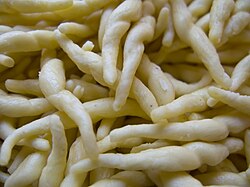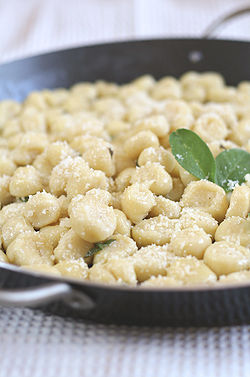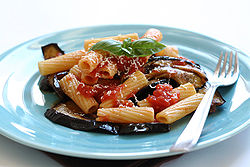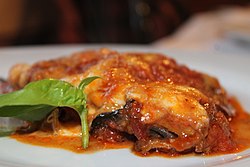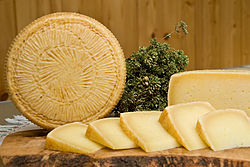 |
| Italian cuisine |
|---|



This is a list of Italian foods and drinks. Italian cuisine has developed through centuries of social and political changes, with roots as far back as the 4th century BC. Italian cuisine has its origins in Etruscan, ancient Greek and ancient Roman cuisines. Significant changes occurred with the discovery of the New World and the introduction of potatoes, tomatoes, bell peppers and maize, now central to the cuisine, but not introduced in quantity until the 18th century. [2] [3]
Contents
- Foods and drinks
- Soups, sauces and condiments
- Creams
- Bread
- Common pizzas
- Pasta varieties
- Pasta dishes
- Rice dishes
- Fish dishes
- Meat dishes and salumi
- Vegetable dishes
- Nut dishes
- Wines
- Liqueurs
- Cheeses
- Desserts and pastries
- Other foods and drinks
- Coffee
- Olive oil
- Vinegar
- Doughs
- Fruits, vegetables and legumes
- Ingredients
- Other common ingredients
- Herbs and spices
- See also
- Notes
- References
Italian cuisine includes deeply rooted traditions common to the whole country, as well as all the regional gastronomies, different from each other, especially between the north, the centre and the south [4] of Italy, which are in continuous exchange. [5] [6] [7] Many dishes that were once regional have proliferated with variations throughout the country. [8] [9] Italian cuisine offers an abundance of taste, and is one of the most popular and copied around the world. [10] The most popular dishes and recipes, over the centuries, have often been created by ordinary people more so than by chefs, which is why many Italian recipes are suitable for home and daily cooking, respecting regional specificities. [11] [12] [13]
Italy is home to 395 Michelin star-rated restaurants. [14] [15] The Mediterranean diet forms the basis of Italian cuisine, rich in pasta, fish, fruits and vegetables. [16] Cheese, cold cuts and wine are central to Italian cuisine, and along with pizza and coffee (especially espresso) form part of Italian gastronomic culture. [17] Desserts have a long tradition of merging local flavours such as citrus fruits, pistachio and almonds with sweet cheeses such as mascarpone and ricotta or exotic tastes such as cocoa, vanilla and cinnamon. Gelato, [18] tiramisu [19] and cassata are among the most famous examples of Italian desserts, cakes and patisserie. Italian cuisine relies heavily on traditional products; the country has a large number of traditional specialities protected under EU law. [20] Italy is the world's largest producer of wine, as well as the country with the widest variety of indigenous grapevine varieties in the world. [21] [22]















